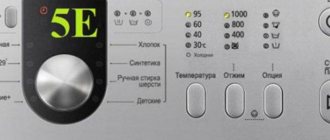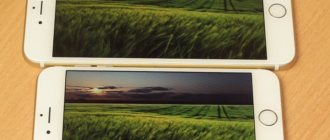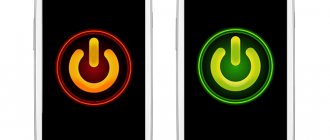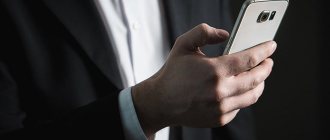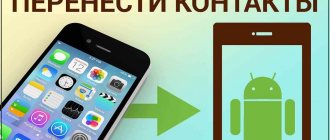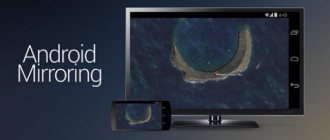Ergonomics
How a smartphone fits in your hand, whether it’s comfortable to swipe and press buttons, are important factors in the ergonomics of a phone. In this case, both iPhone and Samsung are almost the same.
The only thing is that due to the large screen of Samsung, it is quite difficult to reach the opposite corner of the screen with your thumb. This factor will affect those who like to use their smartphone with one hand. But it’s easier to press the lock button on Samsung, because it’s located on the side.
As for the buttons, the iPhone has a sound (silent) switch. Samsung doesn't have such a feature. The result according to the “Ergonomics” criterion is a draw! Smartphones have both advantages and slight disadvantages.
Additional features
You can decide between iPhone 7 and Samsung Galaxy S7 Edge by checking out the various features that both smartphones offer.
- Advantage of SIM cards . One of the most important components is the SIM card. The iPhone traditionally has one port built-in, while the Galaxy has two ports at once. Both phones work with VoLTE networks, so everyone chooses based on the need to work with 2 SIMs.
- Capacity comparison . If you take into account the amount of internal memory, it is difficult to say which smartphone is the best. On the one hand, the iPhone acquired a whopping 128 GB, while the Galaxy S7 Edge has only 32 GB. However, Samsung has included a microSD port that supports cards up to 200GB. Thus, in terms of overall memory, the Korean is better, but to achieve this result you will have to spend a certain amount of money.
- Comparison in autonomy . The batteries of the devices are different in volume, but they hold a charge virtually the same. The iPhone received a 1960 mAh battery, which, thanks to the ideal optimization of the smartphone itself (mentioned above), can last up to 2 days without recharging with average use. The Samsung flagship hides a 3600 mAh battery under the cover, which, due to the notorious energy efficiency of Android, holds a charge in about the same way as an Apple device.
- Wireless charging function . However, the South Korean smartphone is distinguished by one feature - wireless charging, which saves the owner from unnecessary and constantly getting in the way of wires.
- Fingerprint scanner . Naturally, both smartphones have a fingerprint scanner on the central button. However, Samsung specialists have found something to surprise here too. The device can measure pulse, which is very popular with many owners who monitor their health.
- Always-On Display capability . Also, the Galaxy S7 Edge now has an Always-On Display function, which displays information about time, date, weather and upcoming events marked on the calendar when the screen is locked and turned off.
Screen
Objectively evaluating the screens of completely different smartphones from different manufacturers is quite difficult. Brightness margin in the sun, readability and visibility of the screen in the sun are quite objective parameters, but resolution, size and color rendition are subjective factors.
For example, someone has an excellent tablet, and they simply don’t need a large smartphone screen. When shooting with a camera, the screen does not matter at all, and sometimes even the opposite - the more compact and smaller, the better.
Anyway, let's get back to the review. Screen resolution should increase with size, in other words the determining factor here is pixel density. The iPhone uses a resolution of 1136x640 (326 pixels/inch versus 426 for Samsung), which is even less than Full-HD. Despite this, the iPhone screen is clear, and it is almost impossible to see individual pixels. GALAXY uses a higher resolution, but due to the PenTile, the phone will not appear sharp enough.
Color rendering is a fairly objective parameter, but not in our everyday life. Most people prefer bright, acidic shades over natural colors. Neither iPhone nor Samsung can boast of ideal color reproduction. The Samsung is noticeably “blue”, and the iPhone is “red”.
When it comes to sunlight visibility, Samsung gets the win. It's brighter than the iPhone. But we can’t definitely say that the Samsung screen is better.
Software features - branded applications and services
Previously, many people believed that Apple takes the software, and Samsung takes the hardware and bells and whistles. A lot has changed now.
Samsung has caught up and practically surpassed the Americans in terms of software. The company not only created alternatives for popular Apple services (for example, S Health for monitoring user activity or S Memo for saving important information), but also opened the way for manufacturers of high-quality third-party software, providing them with all kinds of support.
For example, two years ago she actively worked with Dropbox. And even data can now be transferred directly from the iPhone via cable; for this purpose, they created a separate migration service that has been working properly for several years.
And the Samsung shell, TouchWiz, becomes a little more stable and at the same time simpler with each version. At the same time, it has long been different from iOS and is developing its own path. And it doesn’t put a spoke in the wheels of its users.
What is Apple doing? Doesn't give third-party software enough freedom - especially on iOS.
There is not a single third-party player for Apple Music. There is no normal access to the capabilities of Siri, to the functionality of the messenger, there is not even a hint of the possibility of built-in call recording - but this is a very useful feature.
Yes, there are advantages to this: the same predictability and uniformity. But in the end, the user suffers.
Each application on iOS runs in a separate sandbox and practically does not interact with each other. In recent years, the situation has changed a little for the better (for example, an SDK for Siri appeared in iOS 10), but for the most part, all this is still in the plans.
Another parity: Apple and Samsung each get 8 points out of 10 - each in this case has advantages and disadvantages.
Usability
For the average user, it doesn’t matter how this or that function is implemented, the main thing is the ease of use. Apple devices win here. They are easy to learn by users, the interface is intuitive, concise, and has a certain minimalism.
If we were comparing an iPhone with Windows Phone, then the situation would be different and victory would go to Windows Phone, which has even less functionality, but at the same time everything is very simple, accessible and understandable.
There could be a completely understandable and accessible smartphone on the Android OS if manufacturers did not overload the interface with a huge number of additional functions and capabilities. Nobody ever uses most of the functions, and in an overloaded menu it is difficult to find the right element among a bunch of settings.
Or take apps for example. When you first launch GALAXY, you find a bunch of shortcuts - these are browsers and various applications for music, movies, books, photos. All applications are duplicated in several copies. Naturally, over time, everything can be customized to suit you - but for this you need to spend time and effort. Some people simply buy the iPhone, the winner in this category, straight away.
iPhone 11 Pro is smaller than Galaxy S10+. But it weighs much more
This is the biggest disappointment and sadness: compared to the iPhone 11 Pro, the largest smartphone in the Galaxy S10 line weighs almost nothing. Even in a leather case.
The weight of the iPhone Pro is 188 g, and the weight of the Galaxy S10+ is only 157 g.
And if you stick glass on the iPhone and put a branded leather case on it, then it will feel like a heavy brick in your pocket. And this is considering the fact that the Galaxy S10+ is larger in size in general and in screen in particular.
This difference in weight is one of the most powerful impressions after changing smartphones.
Camera
The camera on the iPhone and Samsung GALAXY may have different resolutions, however, the photos taken by the devices are almost the same. Let us briefly highlight the main factors:
- Photo sharpness and viewing angle are better on an iPhone;
- Samsung GALAXY has a wider dynamic range;
- iPhone automatically activates HDR mode;
The color rendering of the cameras of both smartphones is a very controversial issue. Samsung GALAXY shows more realistic colors, and on the other hand, iPhone photos are nicer to look at.
For those who like photography, it is better to choose Samsung GALAXY, which has a lot of functions. For those who simply need a camera as an addition to their phone, who don’t want to understand the abundance of functions, but just quickly take pictures at the right time and get good quality photos, the iPhone is your choice.
Comparison of Samsung and iPhone phones
For an objective comparison, we chose the 2 newest and most advanced models of two companies - Apple has the iPhone 11 Pro Max, and Samsung has the Galaxy Note 10+.
Both smartphones are larger versions of the flagship models. They got the biggest screens and the best specs. Let's compare the phones in detail to understand which company is better.
Equipment
A person buying an iPhone already knows approximately what awaits him in the box. There is nothing surprising in the case of the iPhone 11 Pro Max. The device is supplied in a box made of thick cardboard, which has the shape of an elongated rectangle. Inside the buyer awaits:
- Telephone.
- Charging block (9 V, 2A).
- Lightning to USB-C cable.
- Wired headphones Apple EarPods.
- Documentation and stickers.
The regular iPhone 11 without the "Pro" prefix comes with a slow 5V, 1A charger.
The iPhone's equipment looks modest, but at the same time not at all disappointing. The buyer will receive such a set even if he buys a Chinese device. However, it was Apple that set the trend for minimalism in the field of mobile electronics.
The Galaxy Note 10+ has a box very similar to the product of the American company, and almost everything inside is the same:
- Telephone.
- S Pen stylus.
- Charging block.
- USB-C cable.
- Stereo headset with USB Type-C.
- Adapter from MicroUSB to Type-C.
- Paperclip for removing the tray.
- Documentation.
The only thing that deserves special mention here is the proprietary stylus, which is a feature of the entire Galaxy Note line, as well as an adapter from one type of USB to another. However, in terms of equipment, one cannot give an advantage to one of the companies. Everything is similar, everything is minimalist.
Accessories
Since the contents of the package look similar, it is difficult to analyze the pros and cons of the accessories. However, the variability is clearly greater with a smartphone running on the Android OS, where the choice of additional gadgets is simply incredible.
Design and build
The build quality of both smartphones is excellent. The models are made of a combination of metal and plastic. In your hands, such a device feels many times more expensive than a conventional Chinese brand phone. But the iPhone, which has similar dimensions, is much heavier than its opponent: 226 grams versus 196. It’s not a fact that it will be much more comfortable to use than the Galaxy Note 10+.
Design is a purely subjective thing. Initially failed Apple innovations like the “bangs” and the chaotic arrangement of camera modules are becoming a widespread trend. So you shouldn’t make hasty conclusions about the appearance of the iPhone.
Samsung, in turn, has only one controversial solution - the front camera, literally embedded in the screen. No matter what anyone says, this point will irritate the user for a long time. Therefore, it is again quite difficult to determine a clear winner in terms of design and build. But, taking into account ergonomics, we will give a slight advantage to the Samsung Galaxy Note 10+.
Software
Perhaps the main reason Apple fans believe their smartphones are better than the competition is the iOS operating system. It has a closed code, so it is practically not susceptible to viruses. However, installing an application that is not in the App Store or downloading a song will be very difficult.
The answer from Samsung fans is the variability of Android. Even though it is here wrapped in the proprietary shell of the South Korean company, it still does not betray itself. The disadvantages are clear: it will be easy for the virus to penetrate the smartphone’s memory. But, frankly, how often do we encounter similar problems on a mobile device?
Oddly enough, the victory in this comparison has to be given to the iPhone 11 Pro Max. And the point here is not that a closed operating system is good, and an open one is bad. It’s just that Apple devices continue to be supported by manufacturers for a long time, thanks to which the user will receive OS updates with new features for 5-6 years. But on Samsung the support period is a maximum of 3 years.
Memory
It’s worth noting right away that smartphones come in different modifications. To make our comparison fair, we took models in basic versions. And here Samsung wins an unconditional victory. His Galaxy Note 10+ in the basic configuration has 12 gigabytes of RAM and 256 GB of internal memory. For Apple, this figure looks simply ridiculous: 4/64 GB. And if the amount of RAM is a controversial thing, then the internal amount on the iPhone is indeed very small.
Apple can talk as much as they want about the fact that now the era of wireless technologies reigns, and everyone needs to use cloud storage. But this is just another way to suck money out of customers’ wallets.
External media support
A distinctive feature of all iPhones is the absence of a memory card slot. As company executives say, the problem with external media is that it is unsafe. Indeed, some people often complain that their Android smartphone memory card fails after a couple of months. However, this problem only occurs with cheap flash drives. High-quality products can work almost longer than the mobile gadget itself.
Samsung is experimenting in this direction. Some models receive an expansion slot, some do not. By the way, Galaxy Note 10+ allows you to install a memory card. Therefore, the virtual point is again sent to the treasury of the South Korean company.
Display
Smartphones received similar AMOLED screen matrices. But Samsung has an advanced version with the “Dynamic” prefix. The Galaxy also has a larger diagonal: 6.8 inches versus 6.5. The resolution is higher on Samsung: 1440p versus 1242p. But the main difference between the devices of the two companies is the approach to implementing the screen.
Little known fact: Apple buys displays for its devices from Samsung.
The iPhone display has quite noticeable frames and the notorious “notch”, while even the Chinese have learned to make gadgets without unnecessary indents. On Samsung, the screen can even be called endless. Not only does it occupy 91% of the front surface, but it is also curved at the edges, making it seem as if what is happening on the display is coming out. The only thing that spoils the picture is the cutout for the front camera, which to some extent can be compared to a “bang”. So the final verdict will be in favor of Galaxy.
Performance
The flagship segment of smartphones is distinguished by the fact that it always has the most advanced hardware. But the processors for iOS and Android are noticeably different. On Apple, the most productive is the 6-core A13, and on Galaxy, the 8-core Exynos 9825. In synthetic tests, the processor for the iPhone 11 Pro Max wins. And although the difference is practically unnoticeable for now, in 2-3 years the iPhone will still be afloat, and the Samsung owner will need to replace it with a more modern version of the gadget in terms of performance. So the Apple product can rightly be considered more powerful.
The Samsung Galaxy Note 10+, which is sold in the US, has a different processor – Snapdragon 855. It is much more stable than the previously mentioned Exynos.
Photo and video quality
Perhaps this is the main point when comparing gadgets from two different companies. After all, now the smartphone has become not just a smart tool, but also an excellent camera for creating almost professional creations.
iPhone 11 Pro Max received a 12 megapixel front camera, as well as 3 main camera modules:
- The main one is 12 MP (f/1.8).
- 12 MP wide-angle lens (f/2.4).
- 12 MP telephoto lens (f/2.0).
Samsung also has a single front camera of 10 megapixels (f/2.2), and there are 4 main modules at once:
- The main one is 12 MP (f/1.5).
- 16 MP wide (f/2.2).
- 12 MP telephoto (f/2.4).
- Auxiliary lens.
In addition, the iPhone's front camera can shoot video in 4K 60fps, while its competitor has a maximum frame rate of 30 fps. True, the main camera of Samsung, which can shoot slow motion 960 fps, gives a head start.
Be that as it may, these are just numbers. Much more important is how the cameras perform in real conditions. Here, for example, is a photo in the evening, where the iPhone image looks more saturated:
Here's a shot indoors. Subjectively, the image quality on the Galaxy is better.
And, of course, selfies:
It’s quite difficult to say for sure who won in terms of cameras. In this direction, the two objects of comparison have a stronger competitor - Huawei. So let's give Samsung and iPhone an equal number of points.
Signal quality
Although smartphones are now far from being used only as a tool for making calls, signal quality still plays an important role. After all, the speed of the Internet also depends on it. But it is impossible to identify any differences between the two models. They support all Russian networks, and the noise reduction system works while talking on the phone.
Autonomy
The operating time of a smartphone on a single charge is a very important criterion that people always pay attention to when choosing a new device. The iPhone has a 3969 mAh battery, and the Samsung has a 4300 mAh battery. However, other factors also affect autonomy: screen size, processor energy efficiency, and so on. Therefore, you should compare the models head-to-head, putting them on equal terms.
In book reading mode, the advantage, oddly enough, is on the side of the iPhone - almost 23 hours versus 21 for Samsung. But in other tests the product of the South Korean company wins:
- YouTube at 1080p resolution – 14 hours (Samsung), 11.5 hours (iPhone).
- Games – 6.5 hours (Samsung), 5 hours (iPhone).
Over time, any battery wears out, and battery life can drop significantly. Consider this fact when choosing a smartphone.
Warranty service
Each smartphone comes with a 1-day warranty. The free service time can be increased by filling out the appropriate request when purchasing the device. But these are special cases.
In our comparison, it is interesting to find out which phone is more profitable to repair. If you are still asking this question, then the answer is unequivocal - Samsung. Repairs are expensive in any case, but breaking the screen or replacing the battery on an iPhone is comparable to the cost of a good Chinese smartphone.
When purchasing an iPhone, be prepared to spend a lot of money on the potential need for repairs. However, if this is not a problem, this point can be safely deleted from the claims made against Apple.
Price
And now we come to perhaps the most important thing. How much do the heroes of today's comparison cost? The prices in our material are given at the beginning of 2020, but this is a general trend that remains virtually unchanged.
If you take the same store, for example, MTS, the cost of an iPhone will be almost 100 thousand rubles, and a Samsung - 75. Both smartphones are expensive, but the difference between them is quite big.
If you plan to resell your mobile device in the future, the iPhone will fetch more money as a percentage of the purchase and sale price. Apple smartphones fall in price more slowly and are always in incredible demand. Especially on the secondary market. Be that as it may, this fact does not change the fact that Samsung is cheaper to buy a new gadget.
| Characteristic | iPhone 11 Pro Max | Galaxy Note 10+ |
| Display | OLED, 6.5 inches, 1242x2688 | Dynamic AMOLED, 6.8 inches, 1440x3040 |
| Body/screen ratio | 84% | 91% |
| CPU | 6-core Apple A13 | 8-core Exynos 9825 |
| Testing AnTuTu | 462 thousand points | 341 thousand points |
| operating system | iOS | Android |
| Memory | 4/64 GB | 12/256 GB |
| MicroSD slot | No | Yes (up to 1 TB) |
| Main camera | 3 lenses:
| 4 lenses:
|
| Front-camera | 12 MP, f/2.2 | 10 MP, f/2.2 |
| Contactless payments | Yes (Apple Pay only) | Eat |
| Wired connection | Lightning | USB Type-C |
| Battery | 3969 mAh | 4300 mAh |
| Water and dust protection | Yes (IP68) | |
| Dimensions | 158×77.8×8.1 mm | 162.3×77.2×7.9 mm |
| Weight | 226 grams | 196 grams |
| Materials | Metal and glass | |
| Price | 99990 rubles | 74990 rubles |
Autonomy
iPhone and Samsung battery. Regardless of any difference, the iPhone will hold a charge slightly better than the Samsung. After all, the abundance of applications on Android quickly drains your smartphone.
Therefore, autonomy, depending on the battery capacity, may be a draw. But, if the gadgets being compared have the same battery capacity, as a result of an objective assessment we can say that the iPhone is better than the Samsung GALAXY in this criterion.
Samsung wins in terms of functionality and a slightly brighter screen, but those who value the ergonomics of the device, high-quality design, ease of use and a good camera should choose the iPhone.
Although, it’s up to you to choose which is better for you, Samsung or iPhone!

